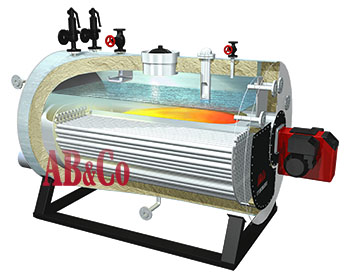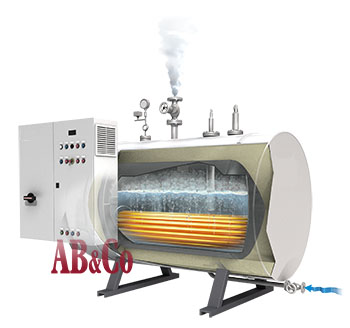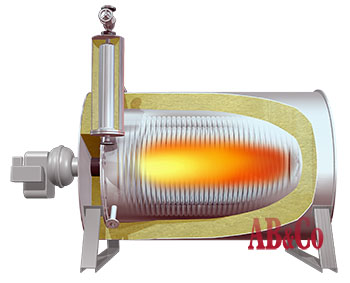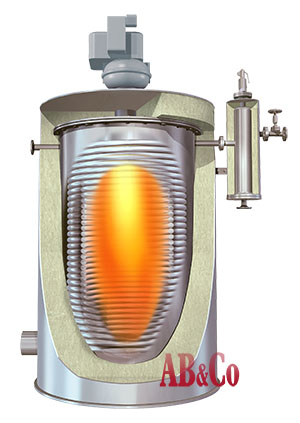|
Steam Heating and High Pressure
Water and steam are typically used as heat
carriers in industrial heating systems.
In industrial heating
systems a high temperature level is often a necessity for achieving the
required high efficiency.
When using steam (or water) these high process temperatures are achieved
by pressurising the steam (or water ).
Dry saturated steam is both very efficient
to carry heat and to deliver and transfer the heat. Saturated steam
offers a very high specific heat content (kJ per kg steam) and thereby
deliver a large amount of heat by a modest steam flow. It also very
efficiently find its way to the heat surfaces, and even more efficiently
transfer the heat to the heat surfaces (large heat transfer coefficient
also called the k-value).
This indeed makes steam very attractive to use
for process heating, and on top of this, it is also a well defined
medium from which engineers worldwide have a lot of experience working
with.

Steam Boiler
(oil/gas-fired)

Steam Boiler (electrical)
These advantages must be considered up
against some significant challenges when dealing with this high
temperature steam.
First of all, dry saturated condition
steam temperature correspond and steam pressure as it appears from the
thermal properties given in so-called steam table:
 AB&CO Steam Table
AB&CO Steam Table
High temperatures saturated steam will always correspond high pressure
steam, and for some high temperature applications this pressure
needs to be extremely high to have the requested heat transfer.
A solution for this is the steam boiler design known as steam generators, where the feed
water evaporates while passing through the piping of a multiple coils (one-through).
With this design it is technical possible to get up to 300°C which
require a steam pressure of 85 barg and a design pressure of nearly 100
barg.
The challenge here is not the steam generator, but the steam
system after. All piping, instrumentation, armatures, tanks and
consumers need to be design in a very high pressure vessel class and
becomes very expensive.


Steam Generator Boiler
Horisontal & Vertical models
(Oil & Gas-fired only)
Note that steam generators in this high pressure design are not
available in standard versions as electrical heated model, although
electrical steam boilers are wrongly often called
"electric steam generator".
Oil Replaces Water and Steam
So the pressurised steam or water
systems easily becomes very
controversial and expensive. However is that has been the situation for
centuries - and has thus been general accepted to deal with -
technically and economically.
There are actually alternatives - high temperatures does not necessary need high
operating pressures!
|
In thermal oil heaters a special oil - a so-called heat transfer fluid (HTF) are
used instead of steam as heat carrier,
and is operating at
atmospheric pressure up to
abt. 300°C.
For comparing this to water and steam, it would require a steam pressure of 85 bar to
obtain this temperature.
There are several advantages by using a thermal fluid (HTF) compare to
saturated steam.
The most obvious advantages are:
 |
High operating temperatures -
up to 300°C at atmospheric pressure. |
 |
Adjustable set-points of
operating temperatures. |
 |
No equipment for pre-treatment
of boiler feed water to maintain. |
 |
No heat loss due to hot
condensate and flash steam - high efficiency and better
operation economy. |
 |
No risk of corrosion and no
risk of freezing damages. |
 |
Low maintenance costs |
 |
Quiet in operation with no
steam stroke or flash steam / condensate noise |

|
Easy to operate (does not
require
steam boiler certified staff) |
But there are also some important limitations in the use of thermal
oil heating.
Often it is advisable to use for instance steam instead of thermal
fluid for installation below ~ 500 kW and ~180°C (heat carrier
temperature).
Thermal oil heating systems eventually becomes quite expensive for
the small installations. When AB&CO deliver small thermal fluid
heaters it is typically only when temperatures up towards 200 -
300°C are required. Thermal fluid also requires a very special
design of the consumer (jackets, heating coils, heat exchangers
etc.).
An important detail in the thermal oil
heating systems is the heat transfer fluid (HTF) which is often an
oil-based fluid (based on natural ingredients or synthetic created). It
is like the blood in your your veins - and thus it plays a major role in the
total shape of the system.

Like any products, this fluid are available on the market in many
qualities. The fluid must be safe and reliable, not only as a brand new
fluid, but also after years of service. It takes an expert to
evaluate the options in choice of fluid since potential side-effects are
numerous especially with cheap HTF. A recommended fluid is this
low-fouling and non-toxic ABCO NF fluid. Opposite fluid distributed by
most oil
companies, which are mostly paraffin based fluid, - this fluid is partly
naphthenic based.
This offers two very important
features for a HTF : First it is more heat resistant (stabile) to
high film temperature (contact to hot heat surfaces) than pure paraffin
based fluid. Secondly the fouling when it eventually arise, does not
lead to deposits on the inside of the tube. Instead the cracked
molecules stays in the fluid and can be filtered out in strainer or
similar on-line cleaning arrangement.
Synthetic HTF are available on the
market also, although they are very stabile at temperatures up to 400°C
- they are normally quite toxic, and must be handled accordingly.
Design of Thermal Oil Heaters
Thermal oil heaters can be delivered in horizontal execution (with low
height), or in vertical execution (occupying limited floor space). They
are delivered complete, insulated and equipped
with burner, armatures, instrumentation, safeties and control panel -
and with full documentation including necessary certificates.

Thermal Oil
Heater
(oil/gas-fired)
The
oil/gas-fired models are made with winded-up coils made of
boiler-certified tubes. The thermal fluid is
heated during the flow through the tube coil. The heat is transferred to the
HTF as radiant heat in the combustion chamber, where the inner
cylindrical tube coil and a flat tube coil forms the chamber walls and
the bottom respectively. Consequently refractory concrete can be
avoided. The combustion gasses are hereafter cooled in the outer
convection part, as the gasses are led between the space of the two tube
coils and the outer boiler shell - in another two pass.
|
The thermal
design with tube coils ensures a modest volume of the thermal fluid relative to the size
of the heater, and it also allows unlimited thermal expansion due to the high
fluid temperature.
The alternative electrical heated models
are also designed allowing a controlled and precise flow rate of thermal
fluid. This is done be multiple long vessels
with electrical elements welded in. The compartment with the elements
are furnished with baffle plates to
ensure high velocity and turbulent flow.

Thermal Oil Heater
(electrical)
As with any other industrial heaters and boilers today, the electrical alternative is
much
more attractive today than previously. Electricity has become clean and cheap in almost
any way. Taxes and duties is another story - a political thing only.
In
practical the capacities are typically below 1,5 MW since the electrical
installation rapidly becomes huge - for instance 1 MW requires a 1,600 A
electrical installation with voltage 3 x 400V.
Ensuring a Safe System with Hot Thermal
Oil
Thermal oil heaters and the complete thermal oil heating systems
should be designed and equipped according DIN 4754.
Both DIN 4754 and different EU codes (incl. PED 97/23/CE and
EN-standards) stipulate that the heaters must follow different
regulation including being designed as pressure vessels - and
consequently manufactured accordingly. This is required despite the
installation and operation are actually considered pressure-less (atmospheric)
and therefore not subject to all the special pressure vessel operation
requirements and maintenance practices & procedures.
Still the heater units must be provided with international recognized and high quality
main components, such as the electric heating elements or the burner for
natural gas, light fuel oil, heavy fuel oil or combinations (dual fuel).
All thermal oil heaters will be carefully checked, controlled and function
tested prior to dispatch from the workshop and are delivered with a full
set of documentation comprising drawings, diagrams, data sheets,
specifications, part list and instruction manuals. In EU the units will
be CE-marked accordingly.
A
correct and safe system design is very important for any high temperature
system. Therefore the requirements for the above codes and standards.
But safety must also be ensured by using only experienced suppliers for
other material, parts and components - and of course also the contractors for
building-up the whole system on site.
The engineers specialising in
thermal oil systems, knows about all those details - and they will
know about the features,
updated technical knowledge of possibilities, options, but also the
threats particular when dealing with these high temperature process
heating systems.
Even when the heaters
are of supreme quality in any details, the HTF inside is
still an oil. At high operation temperatures and insufficient design,
the HTF
can be fatal if not treated correctly.
It must be anticipated that the
local fire regulation codes must be strictly followed. It is highly
recommended that the local chief of the fire department is consulted
prior to projecting the thermal oil heating system - or changes in this.
Generally fire-preventing authorities can always shut-down any projects,
even though all regulations are followed !
Considering all above, it is therefore strongly recommended that the
chosen brand is from a experienced and well reputable manufacturer, and
that the system is made together with a professional and experience
supplier of these systems.
Do
never compromise in quality, it can be both fatal and expensive !
Thermal Oil Heaters
Options & Features
Beside the standard design, thermal oil heaters can also be delivered in
different special executions.
For instance following variations:
 |
Electrical
heated and EX-design (ATEX) |
 |
Flue gas (exhaust gas) heated |
 |
Steam heated thermal oil |
 |
Combination of heat sources |
 |
Container solutions |
 |
Open trailer (mobile) solutions |
 |
Complete skid-mounted units |
 |
Complete unassembled "LEGO" system |
 |
Material in
stainless steel |
 |
Any customised design |
|








